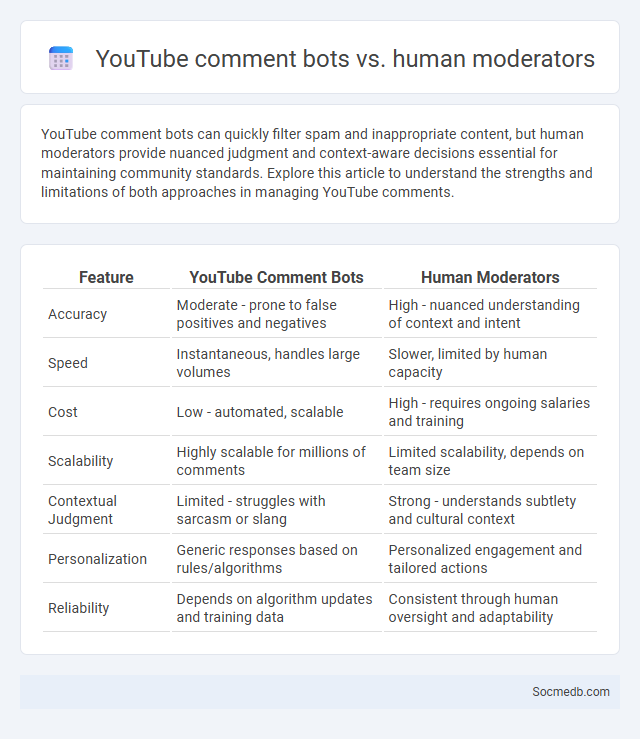
Photo illustration: YouTube Comment Bots vs Human Moderators
YouTube comment bots can quickly filter spam and inappropriate content, but human moderators provide nuanced judgment and context-aware decisions essential for maintaining community standards. Explore this article to understand the strengths and limitations of both approaches in managing YouTube comments.
Table of Comparison
| Feature | YouTube Comment Bots | Human Moderators |
|---|---|---|
| Accuracy | Moderate - prone to false positives and negatives | High - nuanced understanding of context and intent |
| Speed | Instantaneous, handles large volumes | Slower, limited by human capacity |
| Cost | Low - automated, scalable | High - requires ongoing salaries and training |
| Scalability | Highly scalable for millions of comments | Limited scalability, depends on team size |
| Contextual Judgment | Limited - struggles with sarcasm or slang | Strong - understands subtlety and cultural context |
| Personalization | Generic responses based on rules/algorithms | Personalized engagement and tailored actions |
| Reliability | Depends on algorithm updates and training data | Consistent through human oversight and adaptability |
Introduction: The Importance of YouTube Comment Moderation
YouTube comment moderation is crucial for maintaining a positive and safe environment on your channel. It helps filter out spam, offensive language, and inappropriate content, ensuring constructive engagement and protecting your community's well-being. Effective moderation enhances viewer experience, boosts channel reputation, and fosters a trustworthy space for meaningful interactions.
Overview: YouTube Comment Bots Explained
YouTube comment bots automate posting repetitive or spammy comments to boost engagement artificially or promote certain links. These bots use scripts or AI to mimic human interactions, often undermining authentic community discussions and violating platform policies. Understanding their operation helps creators and moderators identify suspicious activity and maintain genuine audience interaction.
Human Moderators: The Human Touch in Comment Moderation
Human moderators play a crucial role in social media comment moderation by applying nuanced judgment and empathy that automated systems often lack. Your online community benefits from their ability to interpret context, detect subtle nuances, and manage complex or sensitive content effectively. This human touch ensures a safer, more respectful environment that fosters genuine interaction and reduces harmful behavior.
Comment Moderation Tools: Automated vs Manual Approaches
Comment moderation tools on social media platforms vary between automated systems using AI algorithms for real-time detection of spam, hate speech, and inappropriate content, and manual approaches involving human moderators to review flagged comments with higher contextual understanding. Automated tools provide scalability and speed, but can struggle with nuances and sarcasm, leading to false positives or missed harmful content. Manual moderation offers precision and context sensitivity but is resource-intensive and slower, often used in combination with automated systems for optimized content management.
Efficiency Comparison: Speed of Bots vs Humans
Bots outperform humans in social media tasks by processing vast amounts of data and executing repetitive actions at high speeds, significantly boosting efficiency. Your social media engagement benefits from bots' rapid responses and continuous operation without fatigue, unlike humans who work slower due to cognitive and physical limits. The efficiency comparison highlights bots' advantage in automating content posting, monitoring trends, and managing interactions seamlessly 24/7.
Accuracy: How Well Do Bots Detect Violations?
Social media platforms rely heavily on advanced bot algorithms to detect violations, achieving an accuracy rate of approximately 85% in identifying harmful content such as hate speech and misinformation. These automated systems utilize natural language processing and machine learning models trained on vast datasets to discern context and intent more effectively. Your content safety depends on continuous improvements in bot detection accuracy, balancing thorough enforcement with minimizing false positives.
Contextual Understanding: Strengths of Human Moderators
Human moderators excel in contextual understanding by interpreting nuanced language, cultural references, and evolving social norms on social media platforms. Their ability to discern intent, sarcasm, and subtlety outperforms automated systems, enabling more accurate decisions on content relevance and appropriateness. This skill ensures a safer and more respectful online environment by reducing false positives and enhancing the quality of user interactions.
Scalability: Handling High Volumes of Comments
Social media platforms employ distributed architecture and cloud-based infrastructure to handle high volumes of comments efficiently, ensuring scalability during peak traffic times. Automated moderation tools powered by AI and machine learning analyze and filter comments in real-time, reducing latency and maintaining user experience. Elastic load balancing and sharding techniques optimize database performance, supporting millions of concurrent interactions without downtime.
Cost Analysis: Budgeting for Moderation Solutions
Effective social media management requires a thorough cost analysis to budget for moderation solutions that balance quality and expense. Your expenses will include software subscriptions, human moderators' salaries, and potential AI integration to enhance efficiency. Allocating resources wisely ensures smooth content monitoring while maintaining community standards and user satisfaction.
Future Trends: The Evolution of YouTube Comment Moderation
YouTube is increasingly leveraging artificial intelligence and machine learning to enhance comment moderation, aiming to reduce toxic content and promote positive engagement. Future trends include more sophisticated natural language processing algorithms that can detect nuanced harmful speech and context-based moderation to better identify borderline cases. This evolution supports a safer, more inclusive community by automating policy enforcement while allowing human moderators to focus on complex issues.
 socmedb.com
socmedb.com